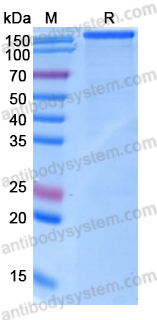Catalog No.
EHD98202
Expression system
Mammalian Cells
Species
Homo sapiens (Human)
Protein length
Met1-Glu1120
Predicted molecular weight
126.32 kDa
Nature
Recombinant
Endotoxin level
Please contact with the lab for this information.
Purity
>90% as determined by SDS-PAGE.
Accession
P32004
Applications
ELISA, Immunogen, SDS-PAGE, WB, Bioactivity testing in progress
Form
Lyophilized
Storage buffer
Lyophilized from a solution in PBS pH 7.4, 1mM EDTA, 4% Trehalose, 1% Mannitol.
Reconstitution
Reconstitute in sterile water for a stock solution.A copy of datasheet will be provided with the products, please refer to it for details.
Shipping
In general, proteins are provided as lyophilized powder/frozen liquid. They are shipped out with dry ice/blue ice unless customers require otherwise.
Stability and Storage
Use a manual defrost freezer and avoid repeated freeze thaw cycles. Store at 2 to 8°C for frequent use. Store at -20 to -80°C for twelve months from the date of receipt.
Alternative Names
Neural cell adhesion molecule L1, N-CAM-L1, NCAM-L1, CD171, L1CAM, CAML1, MIC5
Characterization of tRNA-derived fragments in the small neuron-derived extracellular vesicles of Alzheimer's disease patients., PMID:40436234
In Vitro and In Vivo Studies of Melanoma Cell Migration by Antagonistic Mimetics of Adhesion Molecule L1CAM., PMID:38732030
Label-Free Multiplex Profiling of Exosomal Proteins with a Deep Learning-Driven 3D Surround-Enhancing SERS Platform for Early Cancer Diagnosis., PMID:38624007
Validation of a Proteomic-Based Prognostic Model for Breast Cancer and Immunological Analysis., PMID:38145160
Vesicular HMGB1 release from neurons stressed with spreading depolarization enables confined inflammatory signaling to astrocytes., PMID:38082296
Identification of potential molecular targets for the treatment of cluster 1 human pheochromocytoma and paraganglioma via comprehensive proteomic characterization., PMID:37749499
Interaction of L1CAM with LC3 Is Required for L1-Dependent Neurite Outgrowth and Neuronal Survival., PMID:37569906
Magnetic Separation of Cell-Secreted Vesicles with Tailored Magnetic Particles and Downstream Applications., PMID:37140802
Targeted surface marker screening on neuronal structures in the human choroid., PMID:36586549
Abnormal levels of mitochondrial Ca2+ channel proteins in plasma neuron-derived extracellular vesicles of early schizophrenia., PMID:35867070
β-Amyloid in blood neuronal-derived extracellular vesicles is elevated in cognitively normal adults at risk of Alzheimer's disease and predicts cerebral amyloidosis., PMID:35550625
L1CAM-associated extracellular vesicles: A systematic review of nomenclature, sources, separation, and characterization., PMID:35492832
Antagonistic L1 Adhesion Molecule Mimetic Compounds Inhibit Glioblastoma Cell Migration In Vitro., PMID:35327631
Tear proteomics reveals the molecular basis of the efficacy of human recombinant nerve growth factor treatment for Neurotrophic Keratopathy., PMID:35075190
Inhibition of neutral sphingomyelinase 2 reduces extracellular vesicle release from neurons, oligodendrocytes, and activated microglial cells following acute brain injury., PMID:34678224
Nodal-induced L1CAM/CXCR4 subpopulation sustains tumor growth and metastasis in colorectal cancer derived organoids., PMID:33897875
Chimeric antigen receptor T cell therapy in oncology - Pipeline at a glance: Analysis of the ClinicalTrials.gov database., PMID:33497760
Inhibiting insulin and mTOR signaling by afatinib and crizotinib combination fosters broad cytotoxic effects in cutaneous malignant melanoma., PMID:33082316
Extracellular Vesicles of Alzheimer's Disease Patients as a Biomarker for Disease Progression., PMID:32676990
Expression and function of voltage gated proton channels (Hv1) in MDA-MB-231 cells., PMID:32374759
Tumor-Derived Extracellular Vesicles Impair CD171-Specific CD4+ CAR T Cell Efficacy., PMID:32296437
CD171- and GD2-specific CAR-T cells potently target retinoblastoma cells in preclinical in vitro testing., PMID:31500597
Exosomal L1CAM Stimulates Glioblastoma Cell Motility, Proliferation, and Invasiveness., PMID:31426278
Manufacture of Chimeric Antigen Receptor T Cells from Mobilized Cyropreserved Peripheral Blood Stem Cell Units Depends on Monocyte Depletion., PMID:30315942
Increased L1CAM (CD171) levels are associated with glioblastoma and metastatic brain tumors., PMID:30235708
Temporal expression of CD184(CXCR4) and CD171(L1CAM) identifies distinct early developmental stages of human retinal ganglion cells in embryonic stem cell derived retina., PMID:27867005
Expression of neural cell adhesion molecule L1 (CD171) in neuroectodermal and other tumors: An immunohistochemical study of 5155 tumors and critical evaluation of CD171 prognostic value in gastrointestinal stromal tumors., PMID:27419370
Preclinical Assessment of CD171-Directed CAR T-cell Adoptive Therapy for Childhood Neuroblastoma: CE7 Epitope Target Safety and Product Manufacturing Feasibility., PMID:27390347
Exosomal Proteins as Diagnostic Biomarkers in Lung Cancer., PMID:27343445
Proteome analysis identifies L1CAM/CD171 and DPP4/CD26 as novel markers of human skin mast cells., PMID:27091730
Small-molecule inhibitors of FGFR, integrins and FAK selectively decrease L1CAM-stimulated glioblastoma cell motility and proliferation., PMID:26883759
Characterization of novel biomarkers in selecting for subtype specific medulloblastoma phenotypes., PMID:26497209
L1CAM promotes enrichment of immunosuppressive T cells in human pancreatic cancer correlating with malignant progression., PMID:24746181
Diverse solid tumors expressing a restricted epitope of L1-CAM can be targeted by chimeric antigen receptor redirected T lymphocytes., PMID:24509172
[Research development of L1-CAM(CD171)in human cancer]., PMID:24246931
The immunohistochemical expression of CD24 and CD171 adhesion molecules in borderline ovarian tumors., PMID:24166603
Cell recognition molecule L1 promotes embryonic stem cell differentiation through the regulation of cell surface glycosylation., PMID:24070611
L1CAM stimulates glioma cell motility and proliferation through the fibroblast growth factor receptor., PMID:23212305
Combined treatment of L1CAM antibodies and cytostatic drugs improve the therapeutic response of pancreatic and ovarian carcinoma., PMID:22210381
Circulating levels of cell adhesion molecule L1 as a prognostic marker in gastrointestinal stromal tumor patients., PMID:21600041
L1 stimulation of human glioma cell motility correlates with FAK activation., PMID:21373966
L1CAM regulates DNA damage checkpoint response of glioblastoma stem cells through NBS1., PMID:21297581
L1 is highly expressed in tumors of the nervous system: a study of over 8000 human tissues., PMID:21195422
DOG1 and CD117 are the antibodies of choice in the diagnosis of gastrointestinal stromal tumours., PMID:20716168
Therapeutic antibodies to human L1CAM: functional characterization and application in a mouse model for ovarian carcinoma., PMID:20215505
Syk tyrosine kinase acts as a pancreatic adenocarcinoma tumor suppressor by regulating cellular growth and invasion., PMID:19893036
Stimulation of glioma cell motility by expression, proteolysis, and release of the L1 neural cell recognition molecule., PMID:19874583
Up-regulation of L1CAM in pancreatic duct cells is transforming growth factor beta1- and slug-dependent: role in malignant transformation of pancreatic cancer., PMID:19435915
Subset of esophageal adenocarcinoma expresses adhesion molecule l1 in contrast to squamous cell carcinoma., PMID:19414364
alpha5-integrin is crucial for L1CAM-mediated chemoresistance in pancreatic adenocarcinoma., PMID:19082495

